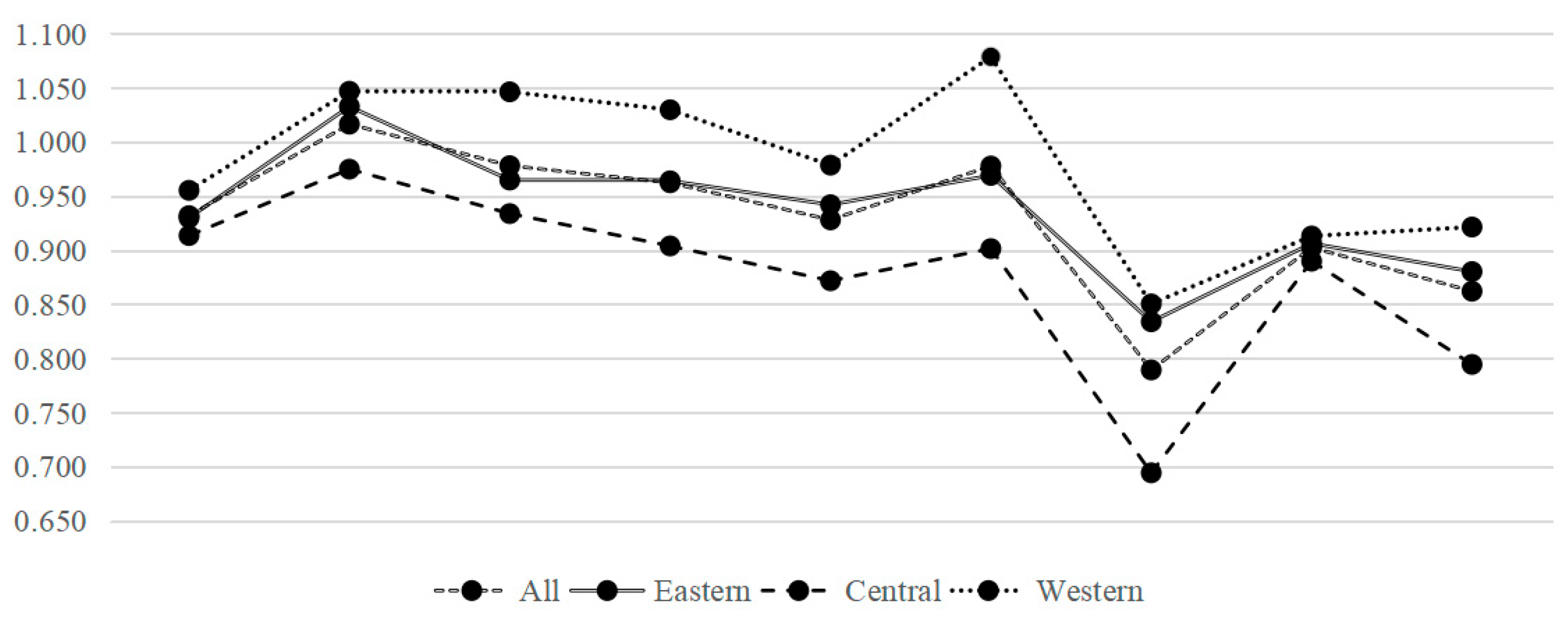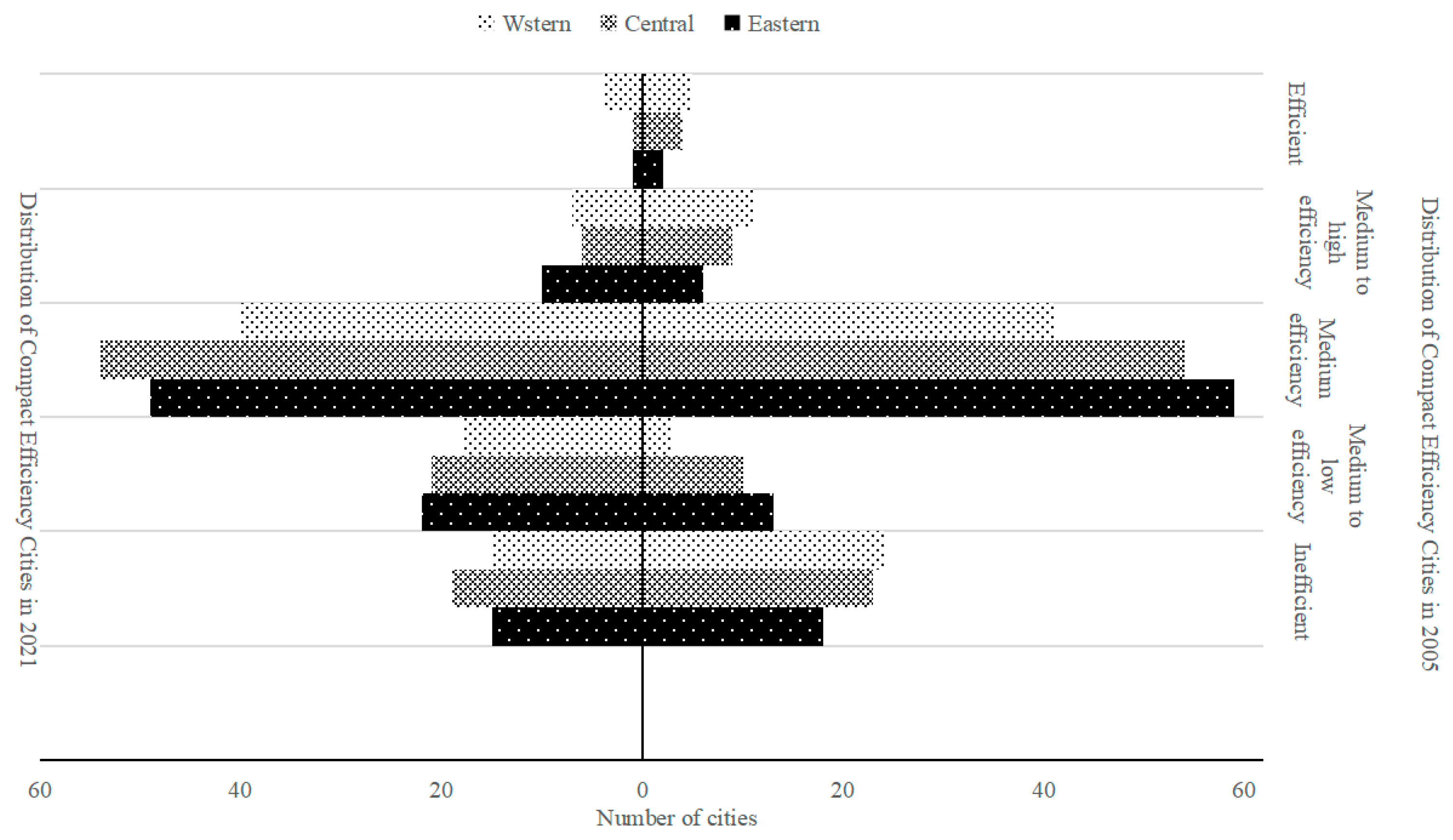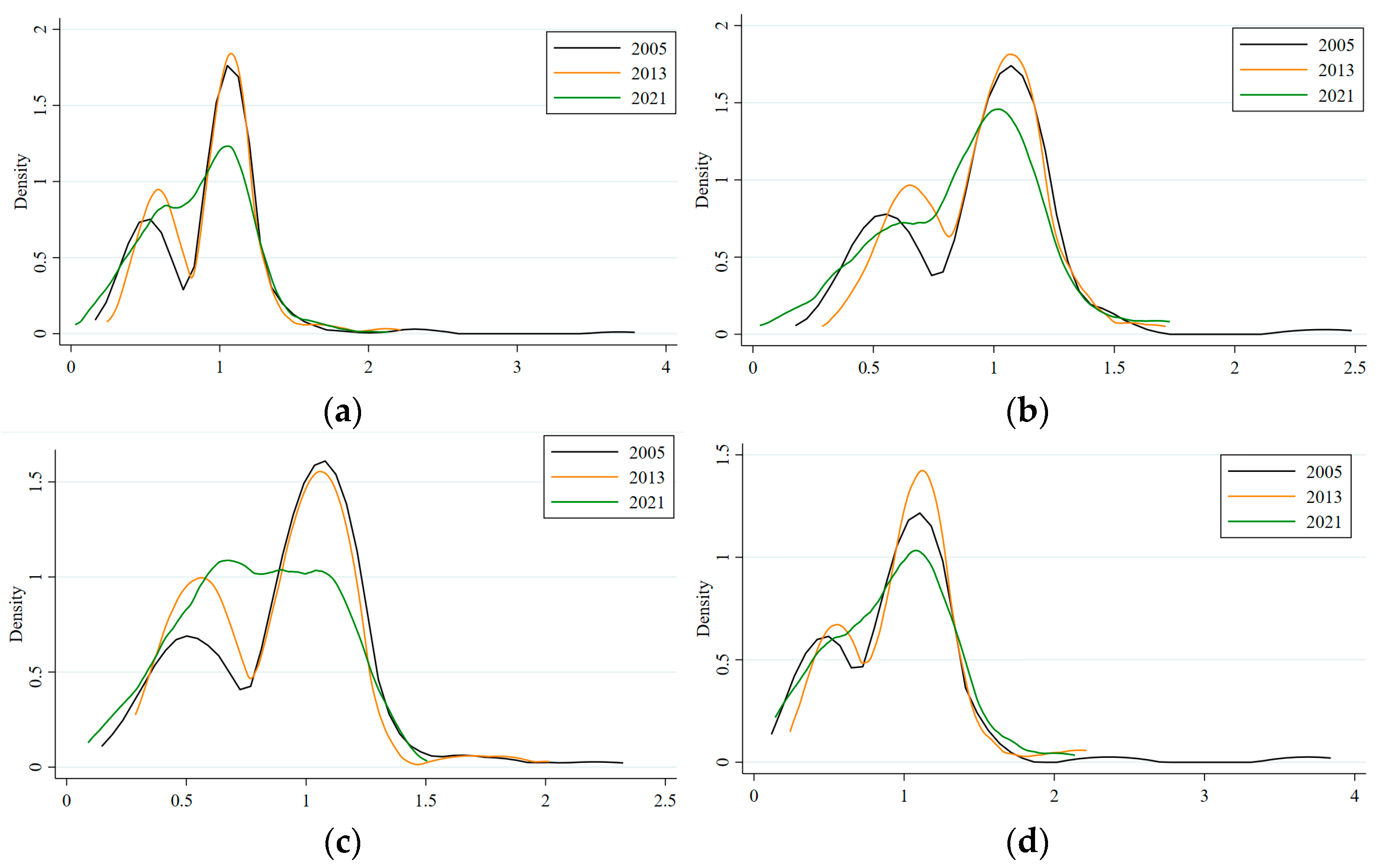Dynamic Evolution and Regional Differences in the Efficiency of Compact Urban Development in Chinese Cities—Based on the Perspective of Compact Land Use
Abstract
:1. Introduction
2. Theory
2.1. Conceptual Framework of Compact Cities
2.2. The Intrinsic Logic of Compact Urban Development
3. Materials and Methods
3.1. Measurement of Compact Urban Development Efficiency
3.2. Research Methodology
3.2.1. Undesirable Output Super-Efficiency SBM Model
3.2.2. Exploratory Spatial Data Analysis
3.2.3. Kernel Density Estimation
3.2.4. Theil Index
3.3. Data Sources
4. Results
4.1. Formatting of Mathematical Components
4.1.1. Evolution of the Overall Spatial Pattern
4.1.2. Evolution of Local Spatial Patterns
4.2. Temporal Evolution Characteristics of Urban Compactness Efficiency
4.2.1. Overall Temporal Dynamics
4.2.2. Local Temporal Dynamics
4.3. Analysis of Differences in Urban Compact Development Efficiency
5. Conclusions
5.1. Main Conclusions
5.2. Main Measures
Author Contributions
Funding
Data Availability Statement
Acknowledgments
Conflicts of Interest
References
- George, B.D.; Thomas, L.S. Compact City: A Plan for a Livable City Environment; Free and Company: San Francisco, CA, USA, 1973. [Google Scholar]
- Tang, Y.; Song, Y.; Xie, J. Analysis of the changes in compactness of urban spatial forms in China from 2000 to 2010. Ecol. Sci. 2016, 35, 134–139. [Google Scholar]
- Morrison, N. The compact city: Theory versus practice—The case of Cambridge. Neth. J. Hous. Built Environ. 1998, 2, 157–179. [Google Scholar] [CrossRef]
- Jia, M.; Liu, X.Y.; Chen, T.; Fan, F. Measurement of compactness for Chinese prefecture-level and above cities. Urban Probl. 2019, 11, 4–12. [Google Scholar]
- Chen, B.Z. Compact and ecological city. Urban Plan. J. 2008, 3, 28–31. [Google Scholar]
- Lü, B.; Qi, L. Implications of compact city theory for urbanization in China. Urban Plan. J. 2008, 4, 61–63. [Google Scholar]
- Xinhua Net. Central Urban Work Conference held in Beijing [EB/OL]. Available online: http://www.xinhuanet.com//politics/2015-12/22/c_1117545528.htm (accessed on 17 June 2022).
- Li, S.C.; Li, X.Y. The impact of compact urban spatial structure on labor productivity: An analysis based on the perspective of regional economic development. Urban Probl. 2017, 7, 42–47. [Google Scholar]
- Rong, P.J.; Liu, H.; Lü, L.Q.; Qin, Y.C. Comprehensive evaluation of compactness of cities in Henan Province based on evolutionary tree model. Reg. Res. Dev. 2019, 38, 48–53. [Google Scholar]
- Li, J.; Xia, S.W. Measurement of compactness and analysis of multiple effects of Chinese mega-cities. Urban Dev. Res. 2016, 23, 109–116. [Google Scholar]
- Wang, J.; Yuan, F. Comprehensive evaluation of compactness of the Yangtze River Delta cities based on the evolutionary tree model. Resour. Environ. Yangtze Basin 2014, 23, 741–750. [Google Scholar]
- Huang, Y.B.; Dong, S.C.; Bai, Y.P.; Li, J.; Mao, Q.L. Study on the spatiotemporal evolution characteristics of compactness in Chinese cities at or above the prefecture level. Sci. Geogr. Sin. 2014, 34, 531–538. [Google Scholar]
- Zhang, W.M.; Fang, Q.M.; Liu, T. Evaluation of urban compactness based on grey correlation: A case study of the Chang-Zhu-Tan urban agglomeratio. Urban Probl. 2016, 10, 37–43. [Google Scholar]
- Zapata Campos, M.J.; Kain, J.H.; Oloko, M.; Stenberg, J.; y Zapata, P. Urban qualities and residents’ strategies in compact global south cities: The case of Havana. J. Hous. Built Environ. 2022, 37, 529–551. [Google Scholar] [CrossRef]
- Bibri, S.E. The underlying components of data-driven smart sustainable cities of the future: A case study approach to an applied theoretical framework. Eur. J. Futures Res. 2021, 9, 13. [Google Scholar] [CrossRef]
- Røe, P.G.; Kjærås, K.E.A.; Haarstad, H. The spatialities of the Nordic compact city. In Socio-Spatial Theory in Nordic Geography: Intellectual Histories and Critical Interventions; Springer: Cham, Switzerland, 2022; pp. 191–205. [Google Scholar]
- Gonzalo, A.L. Recent Transformations in the Morphology of Spanish Medium-Sized Cities: From the Compact City to the Urban Area. Land 2023, 12, 1276. [Google Scholar]
- Salvati, L.; Sabbi, A. Identifying Urban Diffusion in Compact Cities through a Comparative Multivariate Procedure. Ann. Reg. Sci. 2014, 53, 557–575. [Google Scholar] [CrossRef]
- Huang, Y.B.; Dong, S.C.; Bai, Y.P. Spatiotemporal characteristics of the relationship between urban compactness and urban efficiency in China. China Popul. Resour. Environ. 2015, 25, 64–73. [Google Scholar]
- Bai, Y.P.; Di, B.X.; Wang, P.L.; Huang, Y.B. Research on c ompactness and its influencing factors along the Longhai-Lanxin-Beijing-Junggar Railway. Econ. Geogr. 2012, 32, 37–42+49. [Google Scholar]
- Sun, F.X.; Lü, L.C. The Impact of Urban Compactness on Urban Innovation in China. Hum. Geogr. 2021, 36, 97–107. [Google Scholar]
- Hao, W.W.; Zhang, M.Q. Empirical Study on the Relationship between Transportation Improvement, Urban Compactness, and Urban Productivity: Based on the Spatial Panel Data Analysis of Chinese Prefecture-level Cities. Econ. Issues Res. 2016, 3, 66–75. [Google Scholar]
- Chen, T.; Zhang, Y.; Wang, Y.G.; Li, Z.Y. Study on the Coupling and Coordination Relationship between Urban Compactness and Ecological Environment Quality from the Perspective of Sustainable Development: Empirical Analysis of Chinese Provincial Capital Cities and Direct-administered Municipalities. Ecol. Econ. 2021, 37, 93–99+107. [Google Scholar]
- Mao, G.X.; Ding, J.H.; Cao, L. Comprehensive Measurement and Driving Force Analysis of Urban Compactness: A Case Study of Jiangsu Province. Sci. Geogr. Sin. 2009, 29, 627–633. [Google Scholar]
- Chen, Z.X.; Xu, Q. Empirical Analysis of Urban Compactness: Based on Guangdong’s Prefecture-level and Above Cities. Urban Obs. 2019, 1, 63–73. [Google Scholar]
- Han, G.; Yuan, J.D. Distribution Characteristics and Spatial Correlation Analysis of Urban Compactness in the Three Northeastern Provinces. Reg. Res. Dev. 2017, 36, 24–28+34. [Google Scholar]
- Zu, J.X.; Ye, C.S. Comprehensive Measurement and Analysis of Urban Compactness in Jiangxi Province. J. East China Univ. Technol. 2013, 32, 338–344. [Google Scholar]
- Shu, G.; Liu, S.K.; Lu, R.C.; Ye, Z.D.; Wang, Y.X.; Wang, J.J. Temporal and Spatial Characteristics of Urban Compactness and Land Use Efficiency in Guangxi from 2003 to 2018. Bull. Soil Water Conserv. 2021, 41, 300–309. [Google Scholar]
- Yang, H.; Lu, X.H.; Kuang, B.; Hou, J. Spatio-temporal Interaction Relationship and Driving Factors between Urban Compactness and Carbon Emission Intensity: A Case Study of Changsha-Zhuzhou-Xiangtan Urban Agglomeration. Resour. Environ. Yangtze Basin 2021, 30, 2618–2629. [Google Scholar]
- Cheng, K.M. Theoretical Mechanism and Empirical Analysis of the Influence of Urban Compactness on Energy Consumption. Econ. Geogr. 2011, 31, 1107–1112. [Google Scholar]
- Dou, J.M.; Tao, Z.P.; Wang, W. The Influence Mechanism of Urban Compactness on Air Pollution. Econ. Manag. 2020, 42, 5–26. [Google Scholar]
- Zheng, H.Y.; Wu, C.F.; Zheng, S.; Zhuo, Y.F.; Zhang, Q. Study on Urban Compact Development and Land Mixed Use from the Perspective of Spatial Consistency: A Case Study of Shanghai. China Land Sci. 2016, 30, 35–42. [Google Scholar]
- Chen, T.; Zhang, Y. The Influence Mechanism of Urban Compactness on Economic Vitality: Empirical Analysis of Chinese Direct-administered Municipalities and Provincial Capital Cities. Urban Probl. 2021, 6, 34–42. [Google Scholar]
- Guo, J.; Yue, W.R. Urban Compactness and Regional Innovation Capacity: A Case Study of Jiangsu Province. Technol. Econ. 2020, 39, 51–58. [Google Scholar]
- Tian, C.S.; Li, J. Research on the Relationship between Urban Compactness and Energy Efficiency in Large Cities. J. Nat. Resour. 2018, 33, 1781–1795. [Google Scholar]
- Han, G.; Yuan, J.D.; Wang, Z.B. Spatio-temporal Evolution and Correlation of Urban Compactness and Urban Efficiency in Jilin Province. China Popul. Resour. Environ. 2017, 27, 20–27. [Google Scholar]
- Hao, W.W.; Zhang, M.Q.; Liu, Z.Q. Empirical Study on the Relationship among Transportation, Urban Compactness, and Urban Productivity: Based on the Panel Data Analysis of Prefecture-level Cities in the Beijing-Tianjin-Hebei Region. Macroecon. Res. 2016, 1, 109–120. [Google Scholar]
- Hong, J.; Cao, X.Q. The Connotation of “Compact City” and Its Adaptability to the Development of Chinese Cities. J. Lanzhou Univ. 2014, 6, 110–116. [Google Scholar]
- Wu, G.C.; Yang, H.; Chong, D. Measurement and Comparative Study of Compact-style Development Efficiency with Unexpected Output in Cities. China Soft Sci. 2021, 2, 79–89. [Google Scholar]
- Zha, J.P.; Cai, W.X. Research on Water Use Efficiency and Spatial Spillover Effects in the Yellow River Basin. Water-Sav. Irrig. 2022, 1, 26–30+35. [Google Scholar]
- Han, C.F.; Song, F.L.; Teng, M. Spatial and Temporal Characteristics, Spatial Clustering, and Governance Strategies of Carbon Emission in the Yangtze River Delta Region. East China Econ. Manag. 2022, 36, 24–33. [Google Scholar]
- Ke NLu, X.H.; Kuang, B. Spatial and Temporal Evolution and Influencing Factors of Green and Low-carbon Land Use in Chinese Cities: An Empirical Study Based on Carbon Neutrality Targets. Urban Probl. 2021, 7, 33–40. [Google Scholar]
- Wang, J.; Zhu, J.; Luo, Q. Measurement and Evolution of China’s Digital Economy Development Level. J. Quant. Econ. Tech. Econ. 2021, 38, 26–42. [Google Scholar]
- Yan, M.T.; Qiao, J.J.; Qu, M.; Zhu, Q.K. Analysis of Spatial and Temporal Differentiation and Influencing Factors of High-quality Green Development Level in the Yellow River Basin. People’s Yellow River 2022, 44, 15–20. [Google Scholar]
- Pan, J.; Zheng, H.L. Spatial and Temporal Evolution Characteristics of Regional Economic High-quality Development Differences. Stat. Decis. 2021, 37, 88–92. [Google Scholar]




| Level | Factor | Index | Calculation Method |
|---|---|---|---|
| Input | Economic Factors | Proportion of Secondary and Tertiary Industry Output | Output of Secondary and Tertiary Industries/GDP (%) |
| Economic Input Intensity | Total Fixed Asset Investment/Area (104 CNY/km2) | ||
| Land Resources | Land Development Intensity | Built-up Area/Administrative Area (%) | |
| Land Utilization Rate | Construction Land Area/Built-up Area (%) | ||
| Human Resources | Population Density | Population/Administrative Area (104 Per/km2) | |
| Proportion of Secondary and Tertiary Industry Employees | Employees in Secondary and Tertiary Industries/Total Employment (%) | ||
| Transportation Facilities | Per Capita Road Area | Urban Road Area/Population (m2) | |
| Efficiency of Public Transportation System | Total Passenger Volume of Public Buses/Number of Operating Buses (10,000 Person-Times/Vehicle) | ||
| Energy Supply | Electricity Consumption | Total Electricity Consumption (104 kWh) | |
| Gas Supply | Total Gas Supply (Artificial and Natural Gas) (104 m3) | ||
| Liquefied Petroleum Gas Supply | Total Liquefied Petroleum Gas Supply (t) | ||
| Expect Output | Economic Dimension | Per Capita GDP Output | GDP/Administrative Area Population (CNY/Person) |
| GDP Density Index | GDP/Administrative Area (104 CNY/km2) | ||
| Social Dimension | Education Services | Number of Primary and Secondary School Teachers/Number of Primary and Secondary School Students in Administrative Area (%) | |
| Medical Services | Number of Hospital Beds in Urban Area/Urban Population (Units/104) | ||
| Social Welfare Level | Total Retail Sales of Social Consumer Goods/Urban Population (CNY/person) | ||
| Ecological Dimension | Per Capita Public Green Space Area | Per Capita Public Green Space Area (m2) | |
| Built-up Area Green Coverage Rate | Green Coverage Area of Built-up Area/Built-up Area (%) | ||
| Unexpected Output | Industrial Pollution | Industrial Wastewater Discharge | Industrial Wastewater Discharge (104 t) |
| Industrial SO2 Emissions | Industrial SO2 Emissions (t) | ||
| Industrial Smoke and Dust Emissions | Industrial Smoke (Dust) Emissions (t) | ||
| Domestic Pollution | Sewage Discharge | Sewage Discharge (104 m3) | |
| Domestic Waste Treatment | Domestic Waste Treatment (104 t) |
| 2005 | 2007 | 2009 | 2011 | 2013 | 2015 | 2017 | 2019 | 2021 | |
|---|---|---|---|---|---|---|---|---|---|
| All | 0.932 | 1.017 | 0.978 | 0.962 | 0.928 | 0.978 | 0.789 | 0.903 | 0.862 |
| Eastern region | 0.930 | 1.033 | 0.965 | 0.964 | 0.942 | 0.969 | 0.834 | 0.906 | 0.880 |
| Central region | 0.914 | 0.975 | 0.934 | 0.904 | 0.872 | 0.902 | 0.694 | 0.890 | 0.794 |
| Western region | 0.955 | 1.047 | 1.047 | 1.030 | 0.979 | 1.079 | 0.850 | 0.913 | 0.921 |
| 2005 | 2007 | 2009 | 2011 | 2013 | 2015 | 2017 | 2019 | 2021 | |
|---|---|---|---|---|---|---|---|---|---|
| I | 0.023 | 0.111 | 0.112 | 0.197 | 0.176 | 0.081 | 0.153 | 0.063 | 0.031 |
| P | 0.259 | 0.005 | 0.003 | 0.001 | 0.001 | 0.001 | 0.001 | 0.048 | 0.195 |
| State | 2005 | 2021 | |
|---|---|---|---|
| Eastern | H-H | Zhongshan, | Jiangmen, Zhuhai, Shenzhen, |
| H-L | Chengde, Suqian, Jining, Yancheng, | Panjin, Jinan, Cangzhou | |
| L-H | Zhaoqing, Jiangmen, Huizhou, | Shantou, Guangzhou, Yancheng, Tianjin, Fuzhou | |
| L-L | Linyi, Xuzhou, Yangzhou, Zhenjiang, | Dalian, Anshan, Yingkou, Anqing, Tongling | |
| Central | H-H | Heihe, Qiqihar, Suihua, Yichun | —— |
| H-L | Shiyan, Huaihua, Xinyang, Bozhou, Huaibei, | Nanyang | |
| L-H | —— | Linfen | |
| L-L | Hefei, Suzhou, Bengbu, Huainan, Chuzhou, Fuyang, Lu’an, | Xuchang, Luohe, Yongzhou, Jingmen, Huanggang | |
| Western | H-H | Hulunbuir, Jiayuguan, Baiyin, Guyuan, Dingxi, Tianshui, Baoshan, | Zhangye, Wuhai, Yan’an, Xianyang, Weinan, |
| H-L | Shizuishan, Mianyang, Ziyang, Zunyi, Guigang, Beihai, | Laibin, Yulin | |
| L-H | Zhangye, Wuhai, Qingyang, | Jiuquan, Ya’an | |
| L-L | —— | Hezhou |
| Year | 2005 | 2007 | 2009 | 2011 | 2013 | 2015 | 2017 | 2019 | 2021 |
|---|---|---|---|---|---|---|---|---|---|
| Overall Difference | 0.0775 | 0.0402 | 0.0532 | 0.0463 | 0.0579 | 0.0593 | 0.1705 | 0.0503 | 0.0844 |
| Inter-Regional Difference | 0.0002 | 0.0005 | 0.0011 | 0.0014 | 0.0011 | 0.0027 | 0.0011 | 0.0001 | 0.0019 |
| Intra-Regional Difference | 0.0774 | 0.0398 | 0.0521 | 0.0449 | 0.0567 | 0.0567 | 0.0567 | 0.0503 | 0.0825 |
| Eastern | 0.0583 | 0.0216 | 0.0373 | 0.0345 | 0.0395 | 0.0365 | 0.0395 | 0.0464 | 0.0738 |
| (26.08%) | (18.95%) | (24.01%) | (25.93%) | (24.06%) | (21.20%) | (24.06%) | (32.21%) | (31.03%) | |
| Central | 0.0705 | 0.0416 | 0.0477 | 0.0530 | 0.0648 | 0.0446 | 0.0648 | 0.0442 | 0.0775 |
| (31.61%) | (35.13%) | (30.38%) | (38.14%) | (37.28%) | (24.59%) | (37.28%) | (30.73%) | (30.03%) | |
| Western | 0.1069 | 0.0587 | 0.0726 | 0.0479 | 0.0676 | 0.0898 | 0.0676 | 0.0617 | 0.0973 |
| (42.10%) | (44.73%) | (43.51%) | (32.94%) | (36.69%) | (49.73%) | (36.69%) | (36.95%) | (36.70%) |
Disclaimer/Publisher’s Note: The statements, opinions and data contained in all publications are solely those of the individual author(s) and contributor(s) and not of MDPI and/or the editor(s). MDPI and/or the editor(s) disclaim responsibility for any injury to people or property resulting from any ideas, methods, instructions or products referred to in the content. |
© 2023 by the authors. Licensee MDPI, Basel, Switzerland. This article is an open access article distributed under the terms and conditions of the Creative Commons Attribution (CC BY) license (https://creativecommons.org/licenses/by/4.0/).
Share and Cite
Ren, W.; Lu, X.; Wei, L.; Yang, H. Dynamic Evolution and Regional Differences in the Efficiency of Compact Urban Development in Chinese Cities—Based on the Perspective of Compact Land Use. Land 2023, 12, 1837. https://doi.org/10.3390/land12101837
Ren W, Lu X, Wei L, Yang H. Dynamic Evolution and Regional Differences in the Efficiency of Compact Urban Development in Chinese Cities—Based on the Perspective of Compact Land Use. Land. 2023; 12(10):1837. https://doi.org/10.3390/land12101837
Chicago/Turabian StyleRen, Wenqin, Xinhai Lu, Linggui Wei, and Hao Yang. 2023. "Dynamic Evolution and Regional Differences in the Efficiency of Compact Urban Development in Chinese Cities—Based on the Perspective of Compact Land Use" Land 12, no. 10: 1837. https://doi.org/10.3390/land12101837
APA StyleRen, W., Lu, X., Wei, L., & Yang, H. (2023). Dynamic Evolution and Regional Differences in the Efficiency of Compact Urban Development in Chinese Cities—Based on the Perspective of Compact Land Use. Land, 12(10), 1837. https://doi.org/10.3390/land12101837






